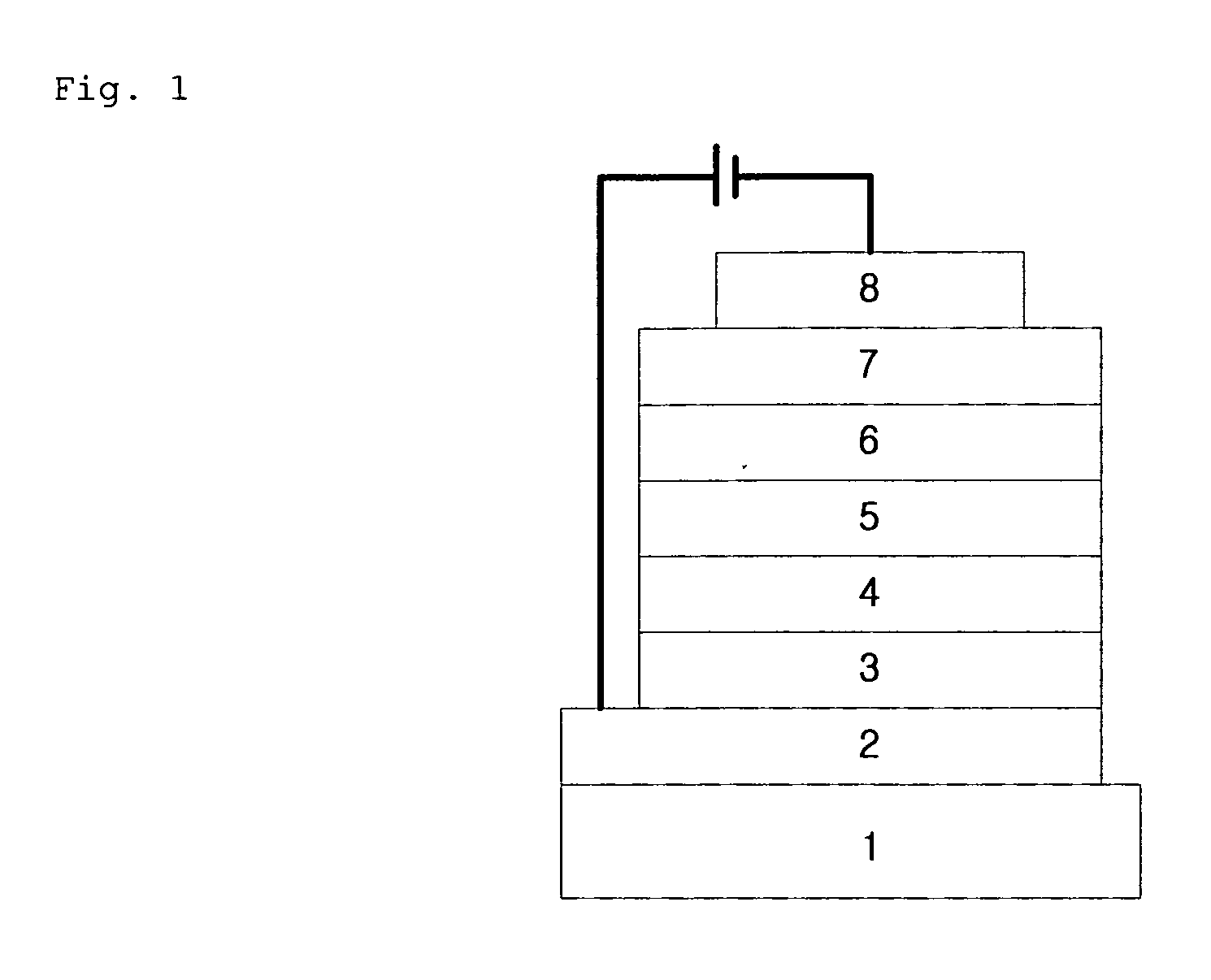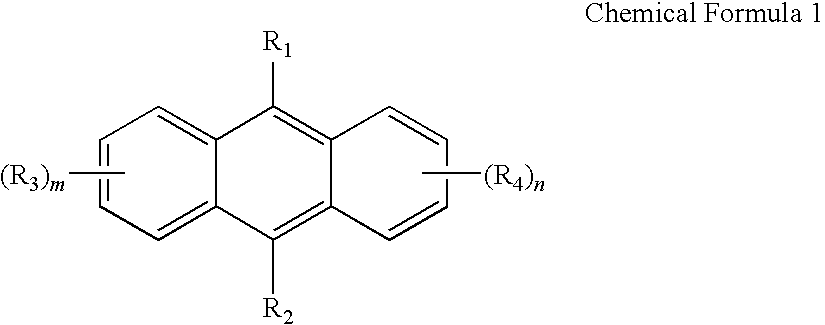Novel organic electroluminescent compounds and organic electroluminescent device using the same
a technology of organic electroluminescent compounds and organic electroluminescent devices, which is applied in the direction of discharge tube luminescent screen, sustainable manufacturing/processing, discharge tube manufacturing, etc., can solve the problems of insufficient enhancement of the lifetime of green materials, insufficient green electroluminescent materials providing long life, and many problems to achieve large-scale manufacturing of panels with low power consumption. , to achieve the effect of improving the life of the device, excellent color purity and luminous efficiency
- Summary
- Abstract
- Description
- Claims
- Application Information
AI Technical Summary
Benefits of technology
Problems solved by technology
Method used
Image
Examples
preparation examples
Preparation Example 1
Preparation of Compound (I)
[0116]
[0117]Preparation of Compound (A)
[0118]A one-liter flask was charged with triphenylamine (40 g, 0.163 mol) and NBS (N-bromosuccinimide) (29 g, 0.163 mol). After adding tetrachloride (820 mL) thereto under nitrogen atmosphere, the mixture was stirred at 70° C. for 4 hours. When the reaction was completed, remaining succinimide solid was filtered off. The filtrate was evaporated by using a rotary evaporator, and the solid produced was washed twice with ethanol to obtain white solid compound (A) (24.8 g, 0.077 mol).
[0119]Preparation of Compound (B)
[0120]Compound (A) (24.8 g, 0.077 mol) was dissolved in THF (140 mL), and n-BuLi (2.5 M in hexane) (33 mL, 0.082 mol) was added thereto at −78° C. After stirring for 1 hour, 2,6-dibromoanthraquinone (7 g, 0.019 mol) was added to the mixture, and stirred for 12 hours. When the reaction was completed, the reaction mixture was washed three times with ethyl acetate and distilled water, and eva...
example 1
Manufacture of OLED's by Using the Organic Electroluminescent Compounds of the Invention
[0126]An OLED device was manufactured by using the electroluminescent compound according to the invention.
[0127]First, a transparent electrode ITO thin film (15Ω / □) (2) prepared from glass for OLED (1) (manufactured by Samsung-Corning) was subjected to ultrasonic washing with trichloroethylene, acetone, ethanol and distilled water, sequentially, and stored in isopropanol before use.
[0128]Then, an ITO substrate was equipped in a substrate folder of a vacuum vapor-deposit device, and 4,4′,4″-tris(N,N-(2-naphthyl)-phenylamino)triphenylamine (2-TNATA) (of which the structure is shown below) was placed in a cell of the vacuum vapor-deposit device, which was then ventilated up to 10−6 torr of vacuum in the chamber. Electric current was applied to the cell to evaporate 2-TNATA, thereby providing vapor-deposit of a hole injecting layer (3) having 60 nm of thickness on the ITO substrate.
[0129]Then, to ano...
example 2
Electroluminescent Properties of OLED's Manufactured
[0137]The luminous efficiency of the OLED's comprising the organic electroluminescent compound according to the present invention (Examples 1) or conventional EL compounds (Comparative Examples 1 and 2) were measured at 5,000 cd / m2 and 20,000 cd / m2, respectively, and the results are shown in Table 2. Since the electroluminescent properties in high luminance region are very important, particularly in case of green electroluminescent materials, the data at high luminance (about 20,000 cd / m2) are attached in order to reflect the properties.
TABLE 2DopingEfficiency(cd / A)Conc.@5,000@20,000No.HostDopant(wt %)cd / m2cd / m2Color1H-2843.021.220.4Green2H-453.019.518.6Green3H-5303.019.719.0Green4H-10313.018.718.0Green5H-11393.018.618.0Green6H-23563.019.418.7Green7H-44763.018.217.5Green8H-56783.018.617.9GreenComp. 1AlqCompound1.010.39.1GreenC545TComp. 2H-28Compound3.016.013.5GreenG
[0138]As can be seen from Table 2, it is found that Compound H-28 a...
PUM
| Property | Measurement | Unit |
|---|---|---|
| Length | aaaaa | aaaaa |
| Length | aaaaa | aaaaa |
| Length | aaaaa | aaaaa |
Abstract
Description
Claims
Application Information
 Login to View More
Login to View More - R&D
- Intellectual Property
- Life Sciences
- Materials
- Tech Scout
- Unparalleled Data Quality
- Higher Quality Content
- 60% Fewer Hallucinations
Browse by: Latest US Patents, China's latest patents, Technical Efficacy Thesaurus, Application Domain, Technology Topic, Popular Technical Reports.
© 2025 PatSnap. All rights reserved.Legal|Privacy policy|Modern Slavery Act Transparency Statement|Sitemap|About US| Contact US: help@patsnap.com



